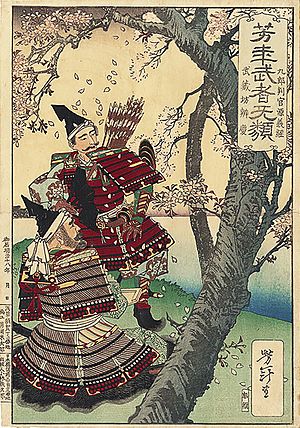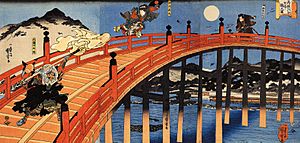Benkei facts for kids

Saitō Musashibō Benkei (西塔武蔵坊弁慶, 1155–1189), often called simply Benkei, was a famous Japanese warrior monk. He lived during the end of the Heian period (794–1185). Benkei had a very interesting life. He started as a monk, then became a mountain hermit, and later a wandering warrior. He eventually became a loyal follower of the well-known warrior Minamoto no Yoshitsune, also known as Ushiwakamaru. Benkei is remembered for his incredible strength and loyalty. He is a popular figure in Japanese folklore, appearing in many old and new stories and plays.
Contents
Benkei's Early Life

Stories about Benkei's birth are quite different. Some say he was born from a temple god. Many stories describe him as a "monster child" with wild hair and long teeth. When he was young, Benkei might have been called Oniwaka (鬼若), which means "demon child." Many famous Japanese woodblock prints (called ukiyo-e) show Oniwakamaru and his adventures. It is said that Benkei defeated 200 men in every battle he fought in.
Benkei decided to join a Buddhist monastery when he was young. He traveled to many monasteries across Japan. Back then, monasteries were not just places for religion and learning. They were also powerful military centers, much like armies. Like many other monks, Benkei probably learned how to use the naginata, a type of spear with a curved blade.
When he was seventeen, Benkei was said to be about 2 meters (6 feet 7 inches) tall! Around this time, he left the monasteries. He became a yamabushi, which is a type of mountain ascetic. These were people who lived in the mountains and practiced strict spiritual training. Benkei is often shown wearing a black cap, which was a common item for these mountain ascetics.
Benkei's Seven Weapons
Benkei was known for carrying seven different weapons. He is often shown with all of them on his back. Besides his sword, he carried:
- A large axe (masakari)
- A rake (kumade)
- A sickle (nagigama)
- A wooden mallet (hizuchi)
- A saw (nokogiri)
- An iron staff (tetsubō)
- A Japanese glaive (naginata)
Benkei's Adventures
Benkei was said to walk around Kyoto every night. He had a goal to take 1,000 swords from samurai warriors. He believed these samurai were too proud and not worthy of their swords. After collecting 999 swords through duels, he was looking for his last one. He then met a young man playing a flute near Gojotenjin Shrine in Kyoto. This much shorter man had a fancy sword at his side.
Instead of fighting at the shrine, they went to Gojo Bridge in the city. There, the huge Benkei surprisingly lost to the smaller warrior. This warrior was Minamoto no Yoshitsune, a son of Minamoto no Yoshitomo. Some stories say the fight happened at Matsubara Bridge instead of Gojo Bridge. Soon after this duel, Benkei was still upset and wanted revenge. He waited for Yoshitsune at the Buddhist temple of Kiyomizu. But he lost to Yoshitsune again! After this, Benkei became Yoshitsune's loyal follower. He fought alongside him in the Genpei War against the Taira clan.
From 1185 until his death in 1189, Benkei stayed with Yoshitsune, even when they were outlaws.
The Standing Death of Benkei
In the end, Benkei and Yoshitsune were surrounded in the castle of Koromogawa no tate. Benkei bravely stood on a bridge, fighting off the enemy soldiers. It is said that the soldiers were too scared to cross the bridge to face him. Anyone who tried was quickly killed by the giant warrior. He reportedly killed over 300 trained soldiers.
Even after the battle should have been over, the soldiers noticed Benkei was still standing. He was covered in arrows and wounds. When the soldiers finally dared to cross the bridge and look closer, the giant man fell to the ground. He had died standing upright! This amazing event is known as the "Standing Death of Benkei" (弁慶の立往生, Benkei no Tachi Ōjō). Benkei was 34 years old when he died.
Today, there is a place called Atago-do, now known as Benkei-do. It has a statue of Benkei that is six feet two inches tall. The statue shows him in the same standing position he was in when he died at Koromogawa. This monument was built between 1711 and 1716, replacing an older one.
See also
 In Spanish: Saitō Musashibō Benkei para niños
In Spanish: Saitō Musashibō Benkei para niños
- Benkei on the Bridge
- Funa Benkei



